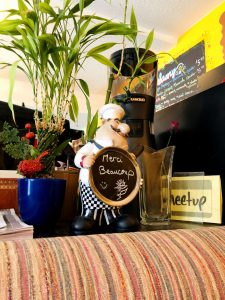Inclusion
Iowa goes bilingual by passing the Seal of Biliteracy legislation which will have a positive impact on our minority and immigrant community.
The Seal of biliteracy legislation was signed into law in Iowa on April 17, 2018. This seal is a distinction awarded by a school district or state to recognize students that are fluent in two or more languages before they graduate. Starting in the spring of 2019, Iowa students will be able to apply to take a test to obtain such certification. The legislation is meant to encourage students to study languages and recognizing students from diverse cultural and linguistic backgrounds. It will open up many opportunities, especially for immigrant students and holds many benefit for college admissions and future employment.
The law aims to affirm the value of diversity by honoring the multiple languages and cultures present in our community. This is particularly important for a state like Iowa that is challenged in diversity since 91.3 percent of the population is white. Encouraging bilingualism promotes culture diversity within the majority of english-speaking students in our state. It also incentivises minority students to learn the languages of their ancestors which were at risk of being forgotten or neglected..
One program at west that best facilitates the learning of bilingual students is the English Language Learners (ELL) classroom. There, students learn about a variety of subjects in english to strengthen their ability to speak the language. “A lot of times, ELL students aren’t advocated enough for … I did part of my student teaching in Ecuador and I realized just how difficult it is to be immersed in another culture and just what it’s like day to day being somewhere where you don’t speak your first language… when I got a little bit of understanding, It made me really want to work with that group of students.” ELL Teacher Amira Nash said.
High school can be a complicated and stressful time for anyone. There is a lot of pressure to look, act, and speak a certain way which can increase the difficulty of school for students who are learning english as a second language. When they are speaking, they don’t have the same correctional resources that they would have in the ELL classroom, and that can be nerve-racking. “I had a student who I can just never get to stop talking, and when I sat in on his business class he was completely silent.” Said ELL teacher Cat Haxton. “When I asked him about it in class he said that he didn’t want to say anything because he was too nervous he would mess up and be judged.”
Andres Fajardo lived in Venezuela for 13 years and grew up speaking Spanish. He remembers it as a diverse and familiar environment where everybody knew each other. His family was very close when they lived there but now after the move he only lives with his mother and father. Andres loves to talk to people but when he first came here he found it was difficult to express himself and that conversations felt uncomfortable. For the most part, people were considerate but some people would laugh or make comments which made heing im feel even worse. Fajardo stays positive and thinks that being bilingual is something to be proud of. “It works like a connection between many different cultures…[being bilingual] I can express myself better and learn things about many different cultures. His reaction to the seal of biliteracy was pure excitement. “I think It could open many doors for me in the future.” “It works like a connection between many different cultures…[being bilingual] I can express myself better and learn things about many different cultures.” — Andres Fajardo
Maria Martin’s parents immigrated to the United States from Mexico before she was born. She grew up in a large, Spanish speaking household, and is what’s considered a native bilingual, which means she knew two languages since before she started Kindergarten.
Martin’s story begins in her grandparents home, a Spanish speaking farm in central Mexico. The familyś plan was that she would live with her grandparents and learn English as well as Spanish until she was old enough to start school. However, a life-threatening skull fracture threw that all out of place.
When Martin was two and a half years old, she got bucked off a mule. Martin and her older sister used to ride a mule down a long dirt road where they would meet the milkman. One day, they were running late and the mule started feeling anxious. Once they were almost there, they could see the milkman was about to drive away so they really had to hurry. The men quickly unloaded the gallons of milk off the animal’s back. the mule started bucking and threw Martin to the ground. “It’s a fun little story” Martin said “I survived, otherwise it probably wouldn’t make anybody laugh.¨
Martin was the last of her family to be born in Mexico. Throughout her childhood, her family made sure that she kept in touch with her mexican roots. The family would spend the school year in Chicago, and the summer in San Juan de los Lagos, Mexico. Her family made sure she kept in touch with her roots talk about not only language but culture. “There’s so much more to language than just the words. You can’t just translate a word and still have them hold the same value… its not just about the words it’s about the meanings, you have to understand the cultural implications of the words.“
Many people don’t understand how hard it actually is to learn a new language, especially at high school age. “The biggest challenge when you’re in highschool and learning a language is that in itself. Sometimes your intellect can be judged by how well you speak the language of instruction when you start learning a language at school age your peers can tell. That said I think that we overwhelmingly have a welcoming community, “It doesn’t take away the stress thought, Of wanting to say something, and knowing what you want to say but not being able to say it in the dominant language of the community.”
Learning a language is a very complicated process that becomes even harder when you learn it later in life. “The brain goes through a period of enhanced plasticity during childhood, making it easier to acquire a first language as well as a second or third language.” Said Dr. Steven Anderson, Director of the Neuropsychological Rehabilitation center at the University of Iowa.
There are many challenges that come with the physiology of learning a language. It requires a complicated amount of muscle memory which is why some people can read and understand years before they can actually speak proficiently. Sometimes people overlook or don’t acknowledge the progress and effort that students are making just because they can’t hear it. “When we’re speaking, we’re training muscles and the easiest one to train is the brain so the brain can read while your tongue and your cheeks and your oral cavity are still struggling to produce the right sound.’ Said Martin
Studies have shown that being bilingual is actually good for the brain. It promotes spatial memory and organization. Bilingual students can also be a lot better at listening and assessing what’s important in a conversation. “Probably the greatest benefit [of bilingualism] is enriched neural representations of knowledge. Our knowledge of things such as objects and concepts is embedded in complex neural circuitry spanning multiple brain regions” Said Dr. Anderson, “By having a bilingual representation of a [word], there is necessarily another node in this complex network supporting the knowledge base.
“There’s so much more to language than just the words. You can’t just translate a word and still have them hold the same value.” — Maria Martin
Aibeer’s family is very close and she thinks that showing how much you love someone is very important.“In my culture, guys can hold hands without anyone saying anything. It’s showing friendship and showing love.”
There’s a lot of people who know even more than just two languages, “It’s interesting because in a predominantly english speaking community, we tend to underestimate the fact that many of our students and families are already bilingual and biliterate, they just aren’t bilingual or biliterate with english yet.” said Martin.
A seal of biliteracy adds an extra level of acknowledgement and motivation to students learning a second language. It praises being bilingual in a more professional and academic setting versus socially and in interpersonal interactions. “This is huge! People being validated in yet one more realm of what they are capable of doing versus highlighting it a deficiency.” Said Martin, “It’s really cool.”










